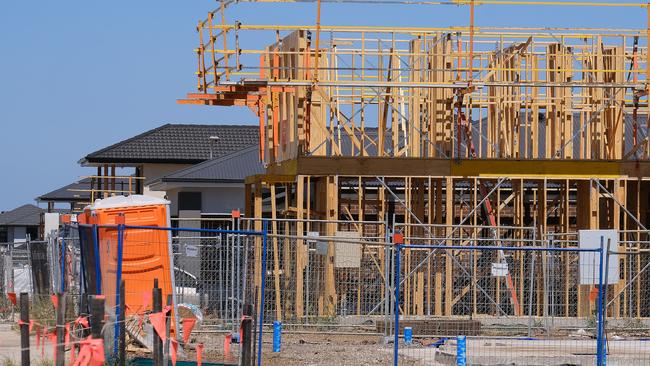RBA warns of 15pc house price slump, but financial system stable
The rapid series of interest rate hikes this year suggests at least a 15 per cent slump in house prices, warns RBA’s Jonathan Kearns.
The Reserve Bank has warned that rising interest rates will impact both home prices and construction activity, but it does not expect this to affect the overall financial system.
The rapid series of rate hikes this year suggest an at least 15 per cent slump in house prices, RBA head of domestic markets Jonathan Kearns said.
But the central bank executive played down the potential impact of house price falls on the financial system, saying that commercial property had played a larger role in earlier crises.
Mr Kearns said that although the global financial crisis was often viewed as a residential property-based crisis the impact on banks had come from commercial property.
“The commercial property market has a much bigger impact on the financial system than does residential property,” he told a Sydney property conference.
“Globally if we all look at the GFC, we all think of it being a residential housing based crisis. In most countries, the impact was actually greater on banks from commercial property.”
But now he said Australia’s banking system has “very little exposure to commercial property” with it making up about 6 per cent of the lending.
“Our banks are pretty well insulated against the commercial property market,” he said. “We certainly wouldn’t expect to see the effects we saw in the late 1990s.”

Mr Kearns noted that household debt was clearly much higher than in the 1980s but argued it had not changed much relative to income, with the RBA now watching the impact of rate rises on individual borrowers rather than simply aggregates across households.
He said a 15 per cent drop in house prices was based on modelling undertaken by the bank earlier this year based on a 2 percentage point increase in interest rates – versus the 2.25 percentage point in hikes delivered since May.
Mr Kearns said while the finding “was commonly reported as being a forecast for housing prices, it was not actually a prediction of how much housing prices would change”.
“Rather it was an estimate of how sensitive housing prices are to interest rates, assuming that all the other costs and benefits to housing don’t change with interest rates.”
“Many factors other than interest rates also influence housing prices. For example, the demand for housing would be greater with stronger household income growth, increased population through immigration, or a preference for fewer people living in each household.
“Conversely, the supply of housing would be lower than expected if construction turns out to be constrained in some way. These factors would all lead to stronger demand, or weaker supply, for housing and so housing prices (and rents) would not fall as much as implied by interest rates acting in isolation.”
If rates stayed 2 percentage points higher “forever”, then the implied fall stretched to 30 per cent, he said. “The impact of interest rates on housing prices importantly depends not only by how much they change, but for how long.”
The average mortgage holder will be paying 25 per cent more on their repayment as a result of the Reserve Bank’s aggressive rate hike cycle this year, Mr Kearns said.
The central bank has delivered 2.25 percentage points of rate hikes in five months, with the potential for another double move of 0.5 percentage points at the October board meeting, which would bring the key cash rate to 2.85 per cent.
Mr Kearns said higher rates were also restricting the maximum loan size available to new buyers by a fifth, although only one in 10 new borrowers did so close to their limits.
“And because the assessment rate also applies to any existing debt, the decrease in borrowing capacity is even larger for prospective borrowers who have existing debt, such as property investors,” he said.
Not all borrowers face higher repayments immediately, with 35 per cent of existing mortgage holders on fixed rates, he said, against 20 per cent historically as record low rates during the pandemic sparked a massive take-up of fixed-term debt.
“And a large share of variable rate borrowers have been making excess mortgage payments into offset and redraw accounts. For many borrowers, these larger payments will mean that actual payments need not increase by the full amount of the change in required payments that result from the higher interest rate.”





To join the conversation, please log in. Don't have an account? Register
Join the conversation, you are commenting as Logout